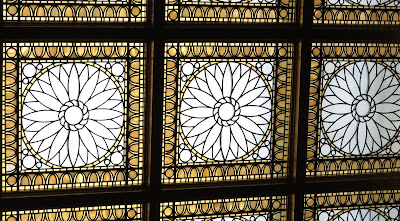All of the furnishings in this room are original and the woodwork is hand-carved mahogany. The colorful marble panels on the walls are Formosa marble from Germany and the columns are Italian Breche Coralline marble. The small columns behind the justices' bench are Benou marble from France and are irreplacable because you can no longer get pieces this large. I loved the nameplate on the desk, but hope it's just a funny coincidence and not truly appropriate.
The Supreme Court contained a skylight too!
The four murals on the walls, painted by Albert Herter of New York, illustrate historical events that influenced Wisconsin law. The painting above the door shows Caesar Augustus Octavius presiding over the trial of a soldier. Above the door is carved the word “LEX”, the Latin word for law.
The painting on the north wall shows the signing of the Magna Carta in 1215 by King John of England, who is being forced to sign by the soldiers and noblemen on the left. The boy with the dog is the artist's son, Christian Herter. He was added to the painting as an afterthought to add balance, and coincidentally later entered politics himself, serving as Governor of Massachusetts and Secretary of State during President Dwight Eisenhower's administration.
The painting at the front of the room illustrates the signing of the United States Constitution in Philadelphia in 1787. George Washington is seated at the desk and the man in the lower right corner with his coat over his arm is James Madison, the inspiration for the name of Wisconsin's capital city. Ben Franklin is in the left foreground and Thomas Jefferson is shown standing to the right of Washington with his foot up on the podium, but he shouldn't be in this painting. Jefferson didn't sign the Constitution nor did he help write it. Herter may have placed Jefferson in the painting because of his influence on American law.
The final mural is an example of territorial law (Wisconsin was then part of Michigan Territory) and portrays the trial of Menominee Chief Oshkosh in 1830. Oshkosh was accused of killing a Pawnee and was brought to trial before federal judge James Duane Doty. Although the jury found Oshkosh guilty of murder, Doty ruled territorial law couldn't be applied to this case because Oshkosh proved he had followed his legal system, tribal custom of law.
My favorite part was the designs in the marble panels though. Each one was different, and they reminded me of those rorschach ink blot tests...but prettier!
The bitter cold should break here by the end of the week and I'm hoping to head to Kettle Moraine for a much needed hike. The Capitol was great and all...but I miss the outdoors. I have a few more posts to finish out our tour, but I think I'll take a break for a couple of days. Stay warm!








In our case it is say dry, you cold weather is coming over here as rain. Wonder ful tour round you state capital building
ReplyDeleteI have really loved these posts and it has bumped your state capitol up on our list since it is one we've yet to visit. Had a fun experience in a restaurant the other night. Our server was obviously not from around here and I recognized the accent because she sounded just like you. When we asked her about it and I guessed Wisconsin correctly, both she and Bill were very impressed! Turns out she and her fiance were passing through over a year ago when their car broke down. It took several days for it to be repaired and by that time, they'd fallen in love with Tennessee and decided to stay. She was a great server with a fun spirit. I recognized that wanderlust and figure they'll not be around forever before moving on somewhere else. Ah, to be young again!!!
ReplyDelete